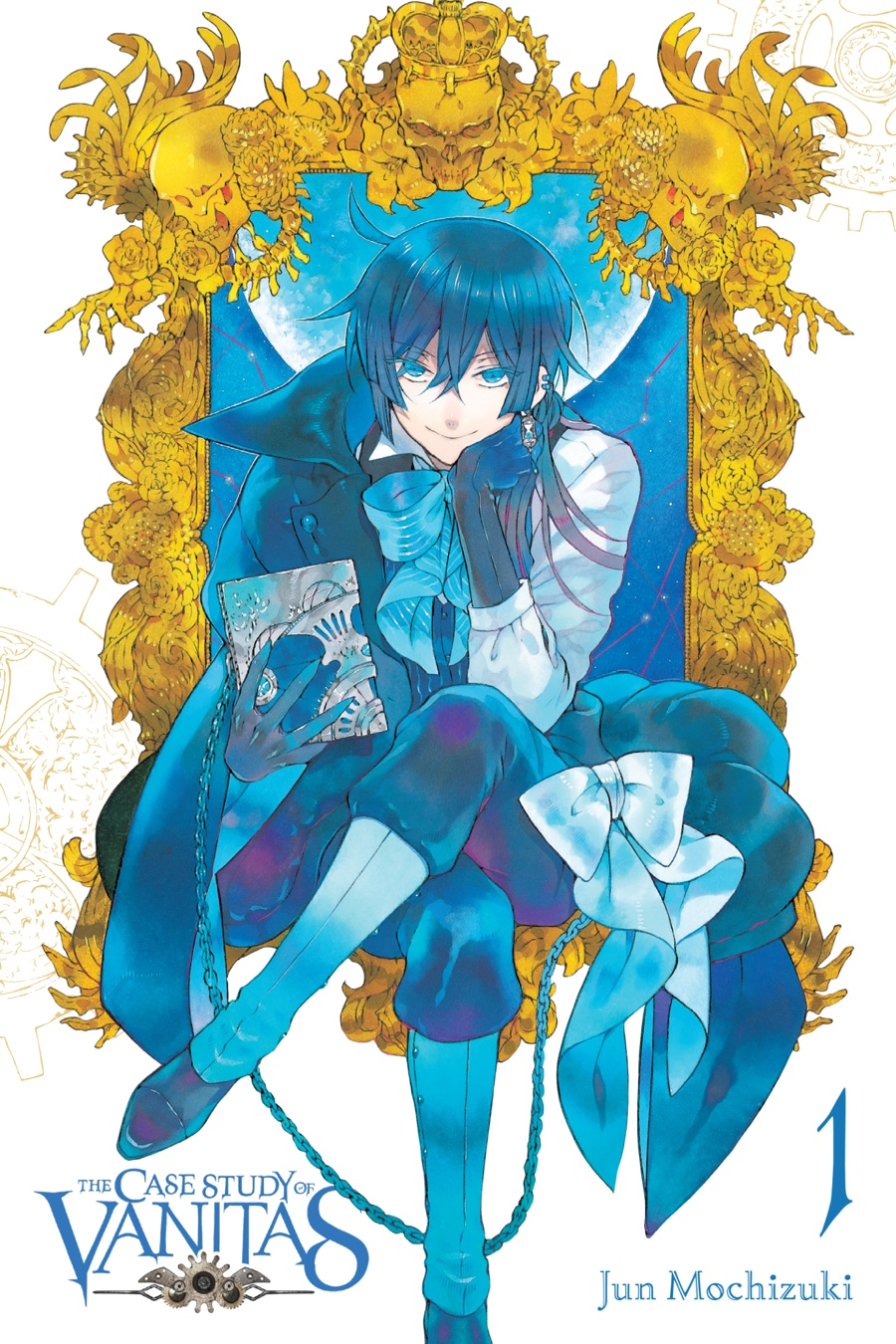Vanitas sits in front of his frame, facing the reader. He has the knowing smile characteristic of him for much of the story up until the Catacombs arc (where contact with his painful past drives away his smug attitude for a bit.) In his right hand is the Book of Vanitas, and the Blue Moon hangs in the night sky behind him. Behind the moon lay the stars and the constellation pattern of formula revision. Despite being a human, the book lets him rewrite formulas the way vampires do. And, as it’s been shown, even without it. He’s also the infamous kin of the Vampire of the Blue Moon, who is said to herald misfortune for the vampires of the Red Moon. Vanitas is a mysterious figure, and he’s not giving away answers anytime soon.
But perhaps his frame will.
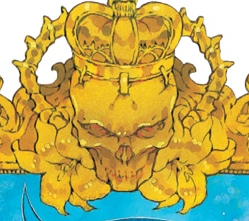
His frame is dense, with vanitas symbols and Victorian flower language crammed up against each other. Starting at the top there’s a skull with a crown riveted to it. Underneath it are lilies. Skulls and bones represent death in vanitas paintings, and its meaning here is pretty straightforward. We are told by Noé at the end of Memoire 1 that Vanitas is going to die by his hands at the end of their journey. Crowns are also a vanitas symbol, indicating the temporary nature of earthly authority. The crown riveted to the skull is conspicuously different from how these symbols are usually depicted, so Mochizuki is making a statement here. We know that Vanitas is kin to the Vampire of the Blue Moon, and Noé has compared Luna’s appearance to Faustina’s. Could Vanitas be connected to vampire royalty through Luna’s resemblance to the queen of vampires? Perhaps Vanitas is being forced to accept a royal inheritance he doesn’t want through the mark of possession. At this point of the story we can’t say for certain. Lastly, underneath the skull are lilies, which mean purity. It’s hard to find a connection between the flowers and the crowned skull, but Vanitas himself has a pure side, revealed when he falls in love with Jeanne.
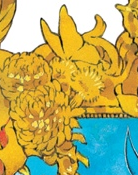
Flanking the crowned skull are butterflies and thistles. The butterfly represents the soul and resurrection in Victorian cemeteries, and also doubles as a vanitas symbol. It’s most frequently associated with Vanitas, but has also been used to represent Noé, or multitudes of people. Vanitas’s association with the symbol for the soul is fitting considering the story as a whole is about him as a person. Noé’s case study began when Noé stayed by Vanitas’s side because of Vanitas himself, rather than what the book could do to help Noé atone for his past failure with Louis. Furthermore, during the Memoire 42 flashback in the Gévaudan arc, Luna said that whether human or vampire, people could never fully understand each other. It looks like this is a topic the story is going to explore in the future.
Thistles have a variety of meanings: retaliation, austerity, conscience, sternness, and independence. Independence fits Vanitas best from what we know of him. He tells Chloé he’s nobody’s ally in Memoire 37, and sees isolation as equivalent to freedom.
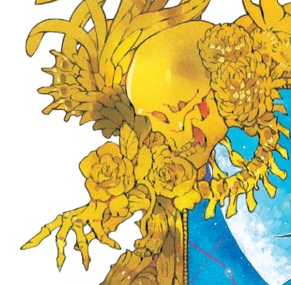
At the top corners are skulls and bones, along with chrysanthemums and roses which continue along the sides. Chrysanthemum means cheerfulness under adversity, which fits Vanitas’s uncaring attitude toward anyone who might hurl abuse at him. Frequently, he enrages other characters: Noé, Jeanne, Luca, Orlok, Ruthven, and Maria to name a few. He does this either as a means to an end or for the sheer fun of trolling. Roses have many meanings in Victorian flower language, and the precise meaning depends on the type and color of flower. Putting aside color, roses mean love and beauty. Love turns out to be quite significant to Vanitas, as he told Noé in their dance in Memoire 12 that he has no interest in anyone who would fall in love with him. He also struggles when he genuinely falls in love with Jeanne, not liking how the feeling is changing him and feeling that it’s impossible for her to return his feelings. Beauty is also relevant to Vanitas. In the story, Johann comments on his beauty in Memoire 3, and in Memoire 49, Luna and Mikhail both imply that Vanitas is beautiful from their comments on his mother, whom Vanitas says he resembles.
Along the sides of the frame are also pomegranates, each sitting in front of a shell. Pomegranates are representations of the forbidden fruit of knowledge that was the cause of Adam and Eve’s exile from the Garden of Eden. In our story, Vanitas hypnotizes himself so that he would kill anyone who would “take his memories.” It might be the case that Vanitas himself contains forbidden knowledge. Pomegranates also have a meaning in flower language, symbolizing foolishness. Vanitas acts foolishly with Jeanne intentionally to get under her skin, and does so unintentionally when he falls in love with her and goes down rabbit holes trying to understand his feelings. At various points of the story he, more often than not and despite acting like a smooth schemer, stumbles his ways through situations recklessly, with unintended consequences.
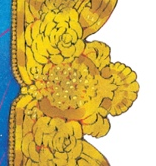
The last symbolically relevant items are the shells. Shells in vanitas paintings indicate the wealth a person cannot bring with them after death. Not much can be said about this with the story told so far. Amelia once said that she didn’t know where he got his money from. Maybe he’s got wealth hidden away?
